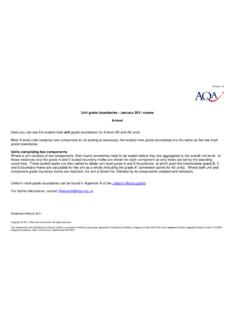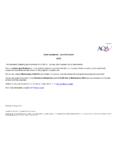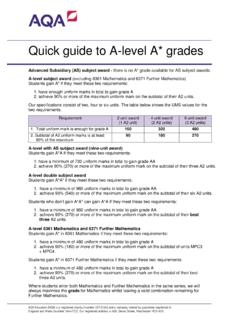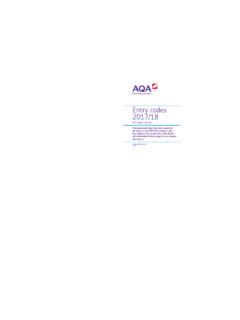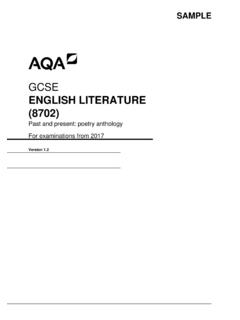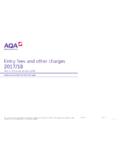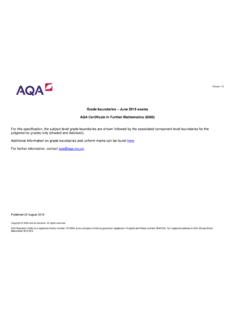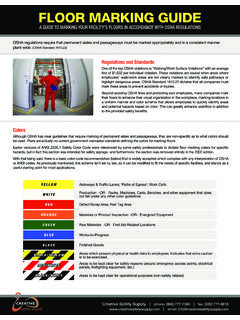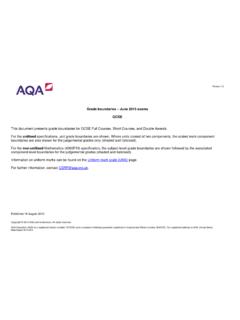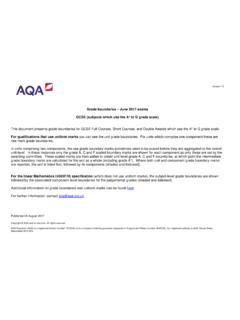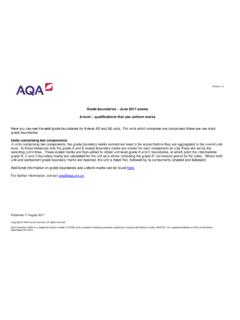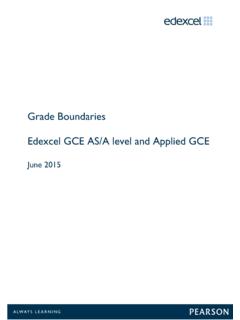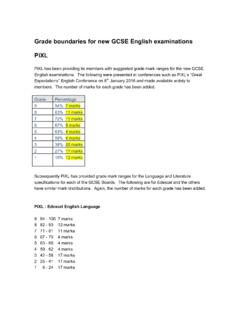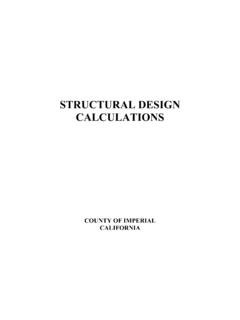Transcription of Guide to the Uniform Mark Scale (UMS)
1 Guide to the Uniform mark Scale (UMS) Uniform marks in A-level and GCSE examsThis booklet explains why the Uniform mark Scale (UMS) is necessary and how it works. It is intended for exams officers and others with a reasonable understanding of the exam system and its more information contact a member of the Centre for Education Research and Practice (CERP) at IntroductionFor some years nearly all A-level, AS and GCSE specifications have used a Uniform mark Scale (UMS).Specifications which use Uniform marks will continue to do so until they are withdrawn. However, Uniform marks are not used in reformed A-level, AS and GCSE exams for first teaching in and after September A contains tables showing the relationship between Uniform marks and grades for our A-level exams which use Uniform marks . For details for AQA GCSE exams which use Uniform marks , please refer to the Uniform marks section of the AQA website ( ).
2 2. Why we need the UMSIn linear specifications, students take all papers in the same exam series. After scaling the raw marks to comply with paper weightings1, students marks are added to give a total mark for the exam as a whole. Using the grade boundaries set by the awarding committee, subject grades are then specifications, on the other hand, allow students to take the module/unit exams in different series. Papers for a particular unit may vary slightly in levels of difficulty. A mark of 45 in summer 2017, for example, may represent the same level of achievement as a mark of 48 in summer 2018. Some method must therefore be found to put the marks from different series on a common, or Uniform , Scale so that both 45 (from 2017) and 48 (from 2018) have the same value when contributing to an overall way of resolving this problem would be to award just grades to students for each unit.
3 The grades could then be equated to points (for example: A=5, B=4, C=3, D=2, E=1 for A-level or A*=8, A=7, B=6, C=5, D=4, E=3, F=2, G=1 for GCSE) and each student s points could be added to give him/her a points total for the subject as a points method would have disadvantages for A-level and GCSE qualifications, as it needs to be modified when the units are not equally weighted and gives the same credit to a student with a low mark in a particular grade as to one with a high mark in that grade . The UMS was developed to avoid the disadvantages of the points method, although the principle is the 2014 all GCSEs became linear. However, because the specifications were largely unchanged, they continue to use Uniform marks until they are withdrawn. A-levels remained modular, and specifications introduced before September 2015 also continue to use Uniform marks until they are reformed GCSE, AS and A-level specifications, for first teaching in September 2015, September 2016, September 2017 or September 2018 (depending on the subject), are linear.
4 A UMS would have little purpose and would introduce unnecessary complexity. Therefore, the awarding bodies and Ofqual agreed that UMS would no longer be used. Please see for the timelines for the introduction of reformed specifications. The details in this booklet do not apply to reformed The term raw mark denotes the original mark given when a paper is assessed. The weighting of a paper is its contribution to the total assessment: for example to say that the weighting is 40% means that the paper accounts for 40% of the total assessment. Raw marks often have to be multiplied by some scaling factor (eg ) in order to give them the correct weighting. The new marks are called scaled marks . See Section TO THE Uniform MARK Scale (UMS)3. How the UMS worksThe relationships between Uniform marks and grades are shown in the Uniform marks section of the AQA website ( ).
5 Details are also provided in Appendix A for A-level and for the GCSE further details of how the UMS varies between different qualifications see Section 4 of this 1 refers to an AS unit marked out of 80 and with a 30 % weighting in a four-unit A-level. The second column shows typical raw mark grade boundaries . These boundaries are determined by an awarding committee following each exam series. For example, the grade A boundary (ie the lowest mark for grade A) is 61 (approximately 76 %).The third column (which is extracted from Table A2 in Appendix A) shows the Uniform mark boundaries . For a unit with 30% weighting in a four-unit A-level, the maximum Uniform mark is 120 and Uniform marks in the range 96 120 correspond to grade A. This does not mean that the paper is marked out of 120 or that a student has to score 80% of the raw marks (96/120) to obtain grade A on the unit.
6 For example: a student who scores 61 (the lowest raw mark for grade A) will receive a Uniform mark of 96 (the lowest Uniform mark for grade A) a student who scores 43 will receive a Uniform mark of 60 a student who scores 49 will receive a Uniform mark of 72 a student who scores 46 (exactly half way between 43 and 49) will receive a Uniform mark of 66 (exactly half way between 60 and 72) see Figure the same principles apply for other qualifications that use Uniform a student has completed all units, his/her Uniform marks are added together. The overall subject grade is then determined using the appropriate table in Appendix A. For example, using Table A2 in Appendix A for a four-unit A-level, a student with a total Uniform mark of 209 obtains grade D, while a student with a total Uniform mark of 199 obtains grade 1 AS unit with maximum raw mark 80 and accounting for 30% of the assessment in a four-unit A-level: typical raw mark grade boundaries , together with the Uniform mark boundaries 2 GradeLowest raw mark in grade (max 80)Corresponding Uniform mark (max 120)A6196B5584C4972D4360E3748(N) 31362 The use of the N conversion point is explained in Section 5.
7 A2 units additionally have an A* conversion point, also explained in Section Uniform mark scales for different A-level and ASIn all awarding bodies, the Uniform mark grade boundaries in A-level are always at the following percentages of the maximum Uniform mark for the unit or qualification: A 80%, B 70%, C 60%, D 50%, E 40%.The maximum Uniform marks are: 600 for a six unit Advanced qualification 400 for a four unit Advanced qualification 200 for a two unit Advanced the Uniform mark grade boundaries for a four-unit qualification are: A 320 (=80% of 400), B 280 (=70% of 400), C 240, D 200, E A-level, grade A* is awarded to students achieving grade A overall and 90 per cent or more of the maximum Uniform mark on the aggregate of the A2 units. For example, in a four unit qualification, grade A* is awarded to students achieving at least 320 Uniform marks on the A-level overall and at least 180 Uniform marks on the sum of the two A2 units.
8 Mathematics and Further Mathematics follow a different rule please see Table A1 in Appendix a unit which accounts for 30% of the total assessment in a four-unit A-level, the maximum Uniform mark is 120 (= 30% of 400). The Uniform mark grade boundaries for such a unit are: A 96 (= 80% of 120), B 84 (= 70% of 120), C 72, D 60, E 48.(see Table A2 in Appendix A and Table 1 in Section 3).In Applied A-level, the units are equally-weighted and all have a maximum Uniform mark of 100, with grade boundaries : A 80, B 70, C 60, D 50, E Applied A-level, grade A* is available in the single award and grades A*A* and A*A are available in the double award. See Table A5 in Appendix A for 1 Conversion to Uniform marks (for part of the mark range) for the data in Table 15 Guide TO THE Uniform MARK Scale (UMS) GCSEIn all awarding bodies, the Uniform mark grade boundaries in GCSEs are at the following percentages of the maximum Uniform mark for the unit/module or qualification: A* 90%, A 80%, B 70%, C 60%, D 50%, E 40%, F 30%, G 20%.
9 As the maximum Uniform marks , numbers of units and unit weightings vary, we can t include details for GCSE specifications in Appendix A. Please refer to the Uniform marks page on the AQA website ( ), where you will find the relationship between Uniform marks and grades for all our qualifications and units which use Uniform Notional N, the A* conversion point and the cap The tables in Appendix A refer to a notional grade N. This is used as a conversion point when calculating Uniform marks from raw marks . There is also a conversion point above the highest available grade called the cap and in A2 units there is an A* conversion N and the cap (and, in A2 units, notional A*) are used to ensure that, on conversion to Uniform marks , raw marks have the same value just above and just below the boundary for both the highest available grade and the lowest available grade 3.
10 When using the cap, a student with a raw mark below the maximum may sometimes obtain the maximum Uniform 2 shows the conversion to Uniform marks for the AS data in Table 1. It extends Figure 1 to cover the whole mark range. The plotted points correspond to grade boundaries (including the maximum mark, the cap, notional N and zero). You can see that: the slope of the graph is the same on both sides of grade A, indicating that raw marks have the same value just above and just below this boundary similarly, the slope is the same on both sides of grade E students with a raw mark above the cap obtain the maximum Uniform mark (120).Figure 2 Conversion to Uniform marks for the data in Table 1 UniformRaw(N)EDCBAUse of cap makes the rate of exchange the same on both sides of the grade A boundary10203040506070809010011012000 Use of the N conversion pointmakes the rate of exchange the same on both sides of the grade E boundary (although it is different below N)1030405060708020(cap)3 Notional N is not used below grade G in GCSE Calculating the cap in an AS unitThe mark width from the A to B raw mark boundaries is doubled and added to the A boundary.
